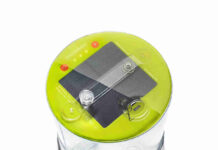Solar cells are a key technology in the drive toward cleaner energy production. Unfortunately, solar technology is not yet economically competitive and the cost of solar cells needs to be brought down. One way to overcome this problem is to reduce the amount of expensive semiconductor material used, but thin-film solar cells tend to have lower performance compared with conventional solar cells.
Yuriy Akimov and Wee Shing Koh at the A*STAR Institute of High Performance Computing have now improved the light conversion efficiency of thin-film solar cells by depositing aluminum particles on the cell surface.
Metallic nanoparticles can direct light better into the solar cell and prevent light from escaping. In conventional ‘thick-film’ solar cells, the nanoparticles would have little effect because all the light is absorbed by the film due to its thickness. For thin films, however, the nanoparticles can make a big difference. Their scattering increases the duration the light stays in the film, bringing the total absorption of light up to a level comparable with that for conventional solar cells. “The strategy allows us to reduce the production costs of solar cells by several times and makes photovoltaics more competitive with respect to other forms of power generation,” says Akimov.
The researchers modeled the light absorption efficiency of solar cells for various nanoparticle materials and sizes. In particular, they compared the properties of silver versus aluminum nanoparticles. In most studies on the subject, silver particles have been preferred. These have optical resonances in the visible part of the spectrum that are even better at focusing the light into the solar cell. Unfortunately, there is a tradeoff: the optical resonances also cause the absorption of light by the nanoparticles, which means the solar cell is less efficient.
In the case of silver, this resonance is right in the key part of the solar spectrum, so that light absorption is considerable. But not so for aluminum nanoparticles, where these resonances are outside the important part of the solar spectrum. Furthermore, the aluminum particles handle oxidation well and their properties change little with variations in shape and size. And more importantly, their scattering properties are robust in comparison with silver nanoparticles.
“We found that nanoparticles made of aluminum perform better than those made of other metals in enhancing light trapping in thin-film solar cells,” says Akimov. “We believe aluminum particles can help make thin-film solar cells commercially viable.”



